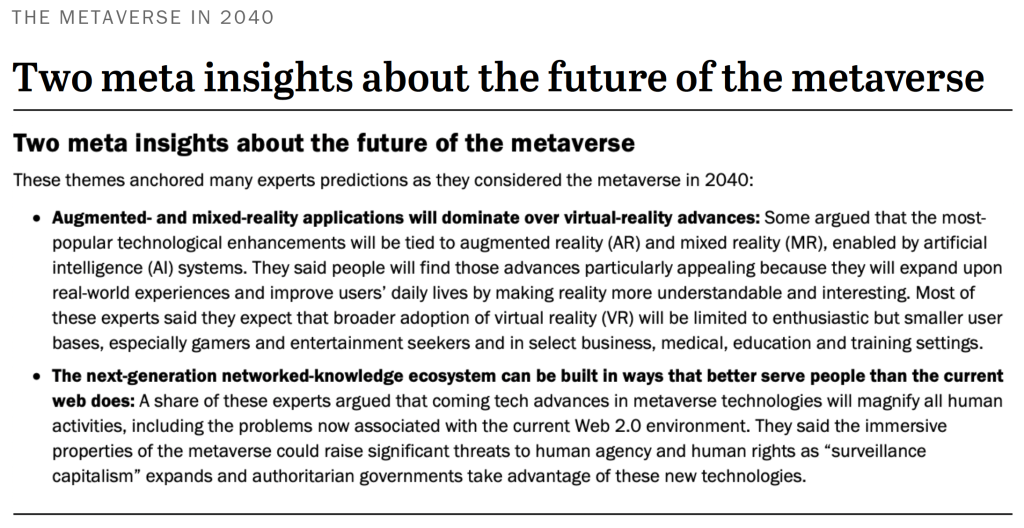The Metaverse and Extended Reality

For years, augmented reality (AR), mixed reality (MR), and virtual reality (VR) have been viewed as standalone technologies that enable immersive experiences in the offline world. Businesses have continued to find ways to use these technologies to improve everyday experiences ranging from shopping to learning.
But we are now viewing these extend reality technologies through a new lens: as building blocks of the metaverse.
A Quick Refresher: What Is the Metaverse?
The metaverse is a virtual world in which people interact through digital twins in immersive environments, as I discuss in this blog post.
The metaverse promises to transform industries ranging from tourism to fashion. But the metaverse is not developing by magic. An immersive metaverse needs several building blocks to realize its potential, including artificial intelligence (AI), extended reality, blockchain, edge computing, and more. Major product developments from companies such as Apple, Google, and Meta have cast a spotlight on these technologies.
Depending on whom you ask, the metaverse exists already. Indeed, aspects of the metaverse exist today; however, they are not yet connected, which metaverse purists believe needs to happen for the metaverse to exist truly.
And the metaverse has enormous economic potential. It will generate $5 trillion in economic value in coming years, according to a recently published reportfrom McKinsey.
Extended Reality in Context
Strictly speaking, VR, AR, and MR are not necessary for the metaverse to exist. Someone using an avatar to play a game on Fortnite does not need extended reality.
And yet, the metaverse has given these technologies a newfound significance. For instance, Meta CEO Mark Zuckerberg’s vision of the metaverse encompasses virtual worlds that can be accessed by extended reality. Meta recently announced that users will be able to log into VR headsets without using a Facebook account, which has been viewed as a way for Meta to transition from a social media-based company to a metaverse-first business.
Extended reality is important for making the metaverse more mature and useful. In a newly published Centific white paper, The Metaverse Technology Framework, we assert that the metaverse experience layer will continue to evolve with more emerging use cases, and that evolution will make the metaverse more appealing to everyday people. It’s only a matter of time for the metaverse to touch all the areas of our lives and become a normal part of the real world.
This is where extended reality comes into play.
Extended reality will uplift the user experience in the metaverse through metaverse-focused devices like AR smart glasses, haptics, hologram displays, and VR headsets. Such devices can facilitate numerous physical services in the virtual world and help users steer through the metaverse smoothly.
For instance, in the tourism industry, VR can inspire travelers to get a first-hand experience of their chosen destination before they plan to visit the place in person. In addition, AR and VR technologies combined with the metaverse can help travelers experience potential hotels before booking. In agriculture, the metaverse can help farmers manage farms remotely. AR and VR combined can provide a better look at the state of the farm, its inventories, storage, weather conditions, and many other parameters. The real-time monitoring of farms can lead to advancements in the agricultural sector.
A recent Pew Research survey of technology thought leaders confirms that extended realities will enable a more useful metaverse in coming years (although the though leaders surveyed also shared concerns about the broader social impacts of the metaverse). As Pew Research recently noted,
Proponents of XR and the development of more-advanced and immersive, 3D, online worlds say its rapid evolution is likely to benefit all aspects of society – education, health care, gaming and entertainment, the arts, social and civic life and other activities. They believe the infusion of more data into people’s experiences, progress in artificial intelligence (AI) assistive systems and the creation of entirely new spaces and experiences for tech users could enrich and expand their lives.
Here's a summary of the most crucial insights from Pew’s research:

Our white paper discusses these technologies in their proper context as building blocks, specifically to enable a better user experience layer. We also examine building blocks such as AI, blockchain, NFTs, crypto currencies, and much more. Together they power the economic foundation of the metaverse. A better user experience is necessary for the foundation to take hold.
We also believe that the social concerns behind the metaverse can be addressed by designing experiences with people at the center, similar to how AI can be more human-centered with a mindful, people-first approach. Centific can help business succeed in the evolving metaverse in three ways:
- Develop a business transformation strategy that links the metaverse to your company’s growth objectives. The metaverse is having far-reaching impacts in all industries and all applications ranging from product development to the customer experience. We can help you define a road map to business transformation with the metaverse.
- Design experiences in the metaverse with people at the center. Our research, design, and development experts rely on tools such as design thinking to ensure that all immersive technologies, including the building blocks of the metaverse, meet human wants and needs.
- Develop the computing infrastructure that powers the metaverse, including enabling technologies such as AI and computer vision discussed in this white paper.
Learn more about our views on the metaverse through our white papers The Metaverse: A New Horizon in Digital Reality and The Metaverse Technology Framework.
Contact us to start succeeding with the metaverse.
